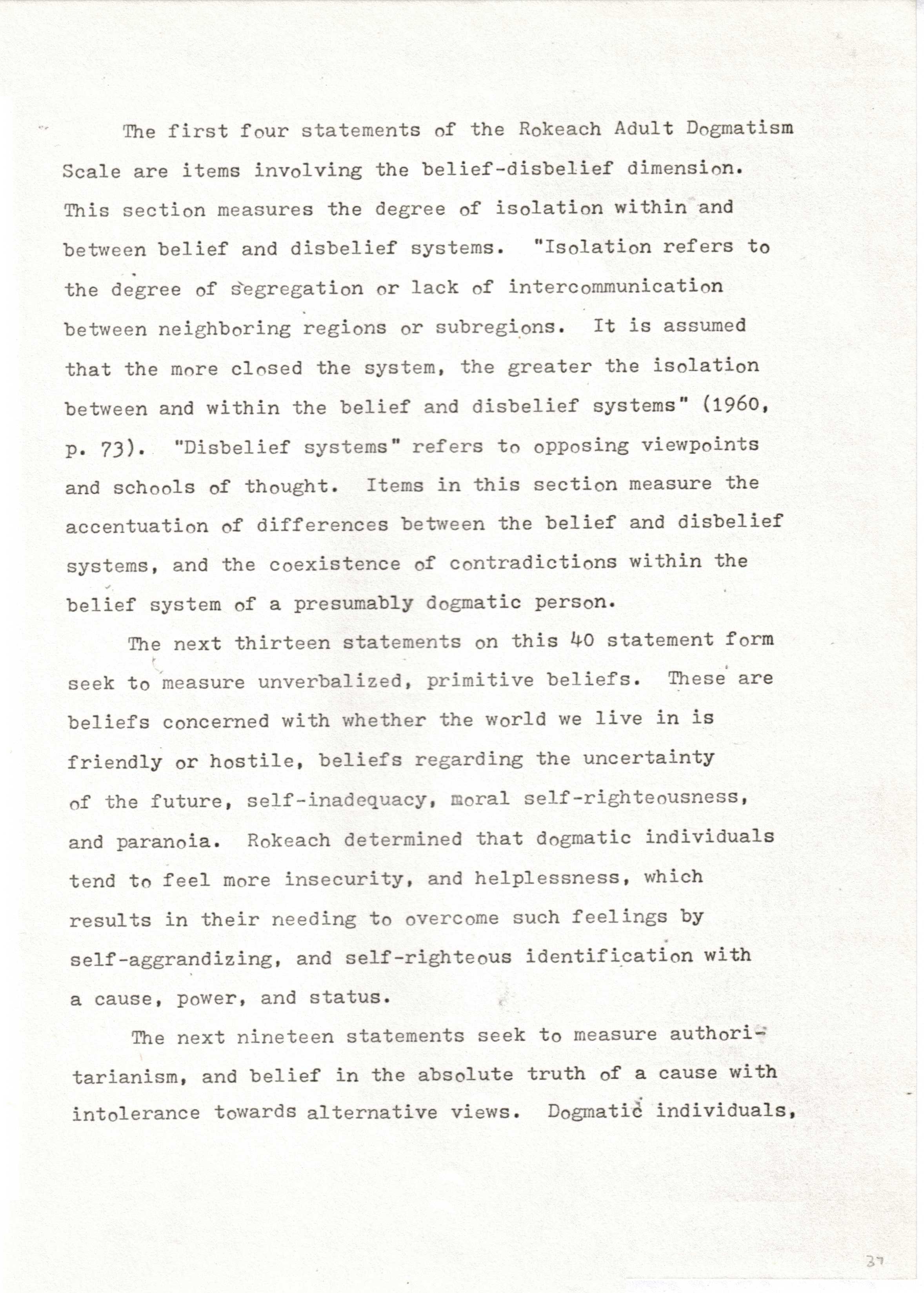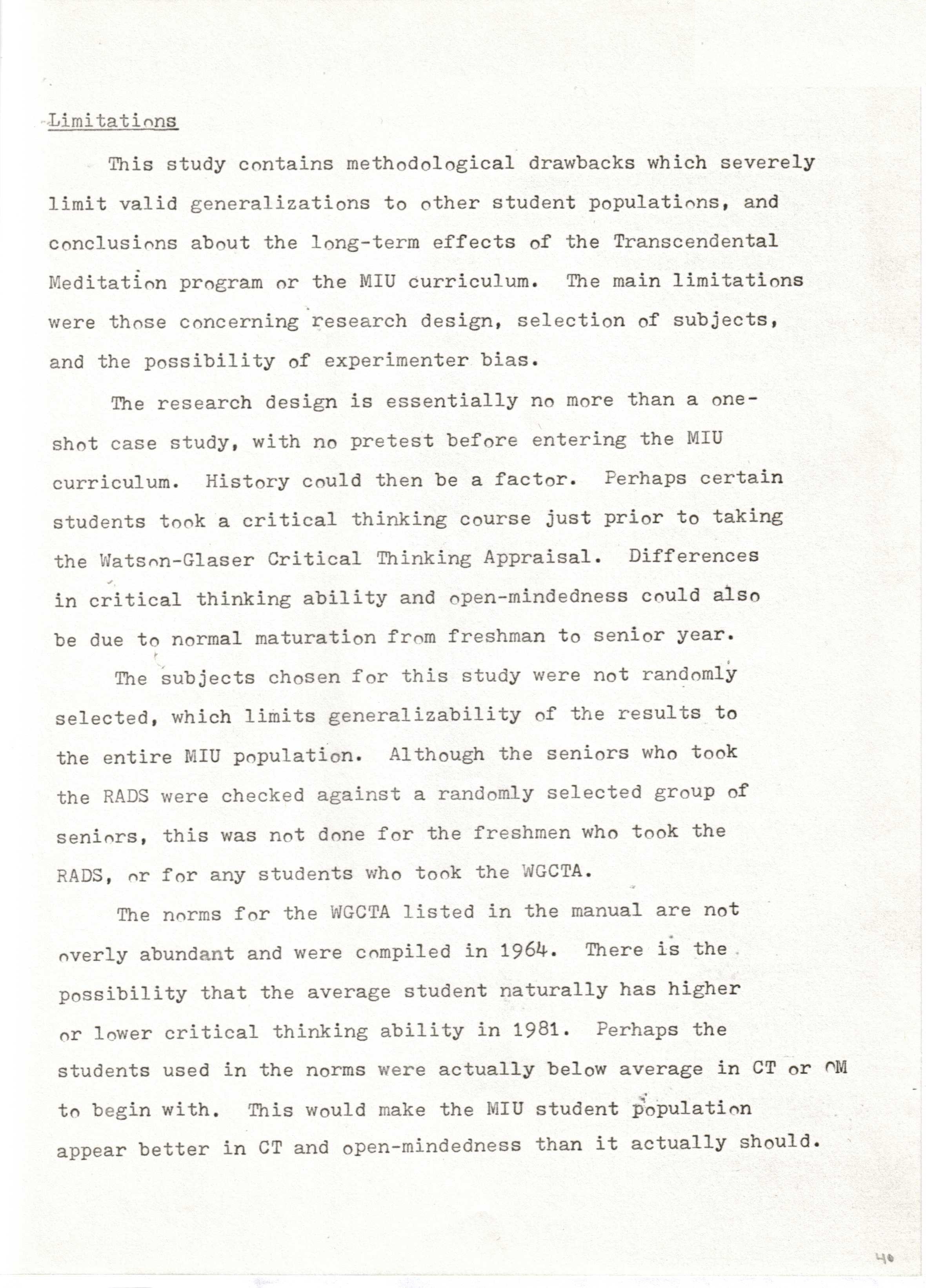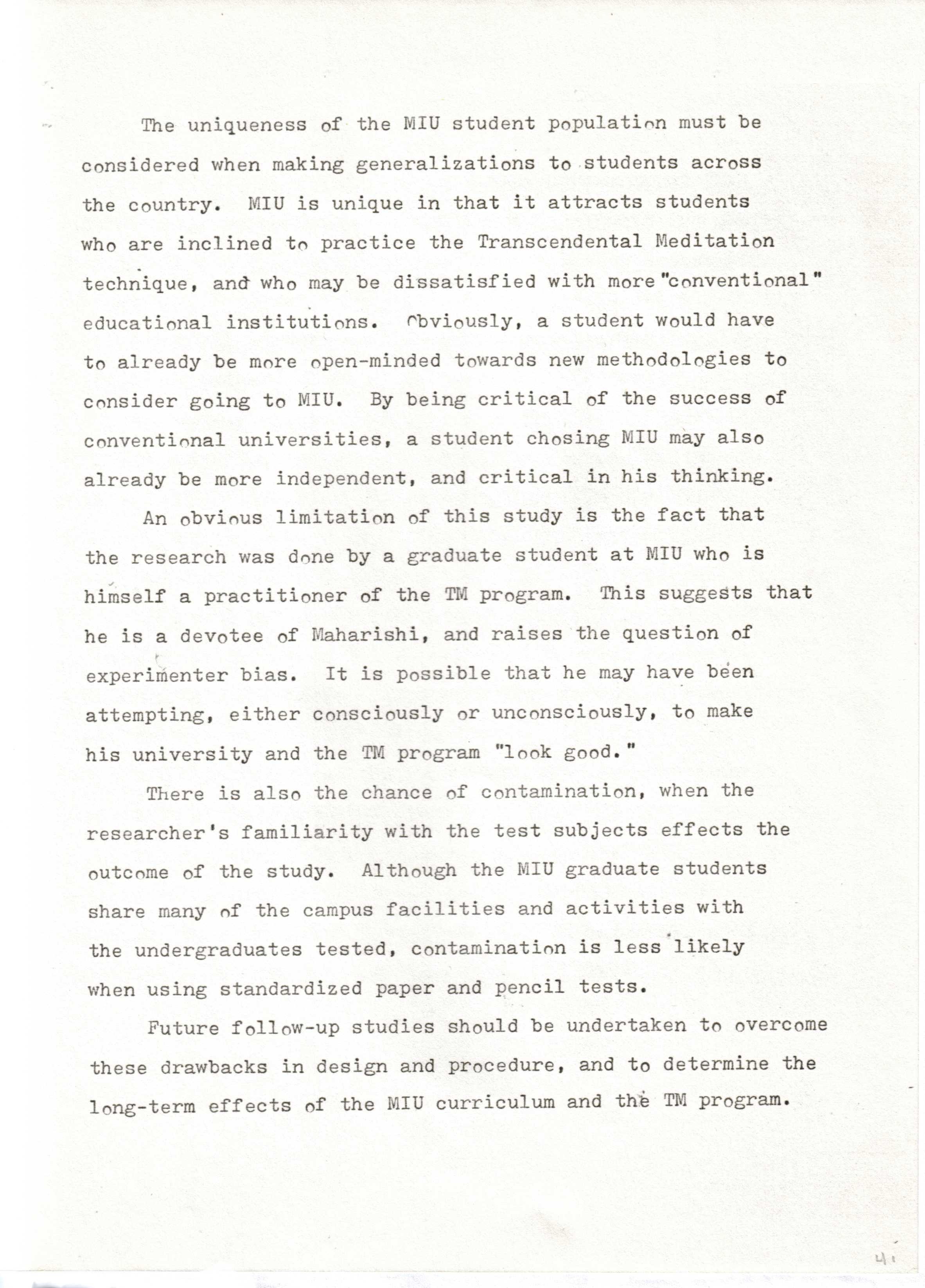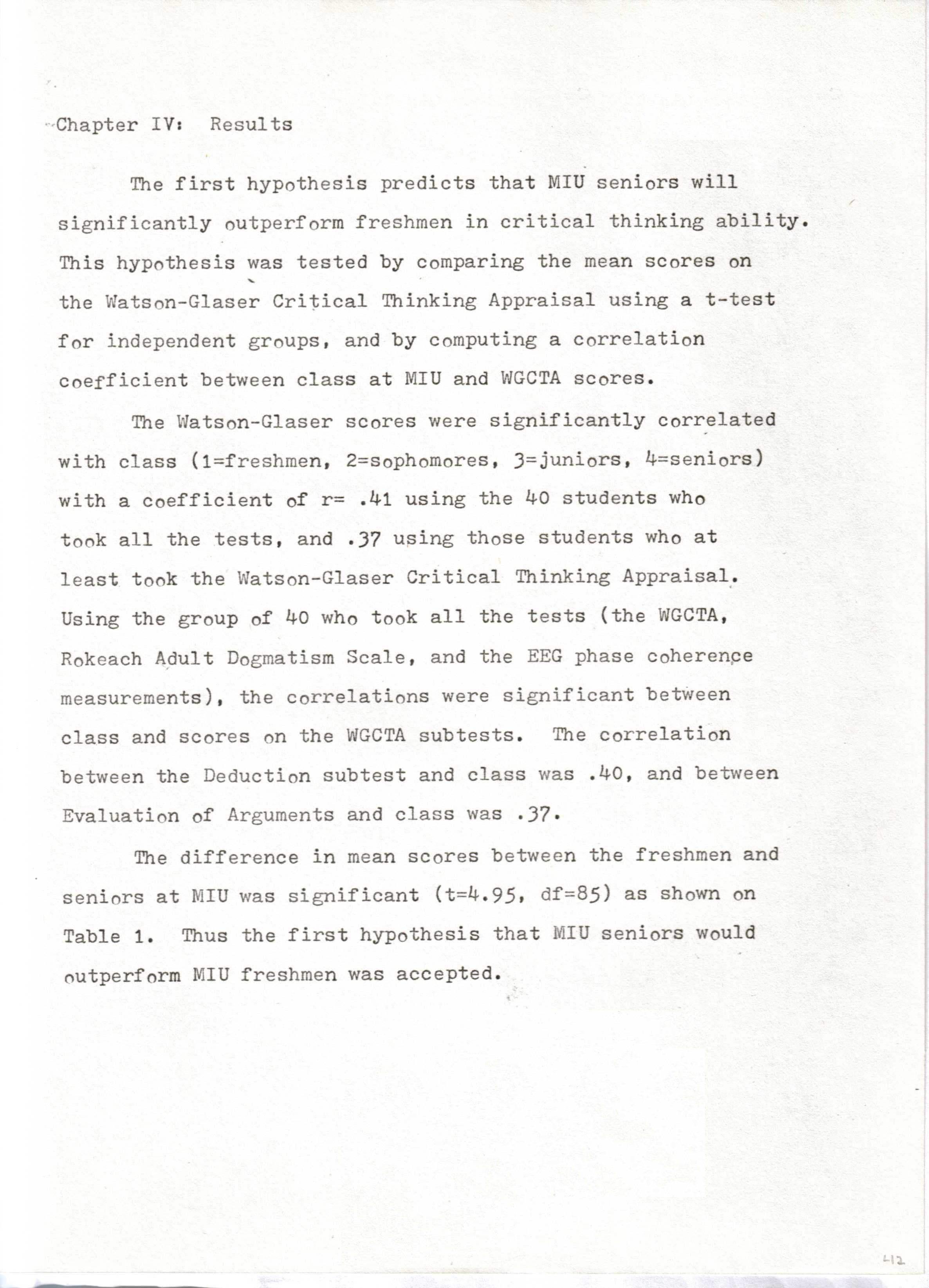
ctomeegmiu37.jpg
|
The first four statements of the Rokeach
Adult Dogmatism
i Scale are items involving the
belief-disbelief dimension.
This section measures the degree of
isolation within and
between belief and disbelief systems.
"lsolation refers to
the degree of segregation or lack of intercommunication
between neighboring regions or subregions. It is assumed
that the more closed the system, the
greater the isolation
between and within the belief and disbelief
systems" (1960,
p. 73). "Disbelief systems' refers to
opposing viewpoints
and schools of thought. Items in this
section measure the
accentuation of differences between the
belief and disbelief
systems, and the coexistence of
contradictions within the
belief system of a presumably dogmatic person.
The next thirteen statements on this no
statement form
seek to measure unverbalized, primitive
beliefs. These are
beliefs concerned with whether the world we
live in is
friendly or hostile, beliefs regarding the
uncertainty
of the future, self-inadequacy, moral
self-righteousness,
and paranoia. Rokeach determined that
dogmatic individuals
tend to feel more insecurity, and
helplessness, which
results in their needing to overcome such
feelings by
self-aggrandizing, and self-righteous
identification with
a cause, power, and status.
The next nineteen statements seek to
measure authoritarianism, and belief in the absolute truth
of a cause with
intolerance towards alternative views.
Dogmatic individuals,
|

ctomeegmiu38.jpg
|
according to Rokeach would tend to be more hostile towards
disbelievers and would seek to isolate
themselves from them.
The last four statements are items
involving the time-perspective dimension. Rokeach assumes that
the more closed
the belief-disbelief system, the more its
organization is
future- or past-oriented, that is, the more
the present
will be rejected as important in its own
right.
|

ctomeegmiu39.jpg
|
Instruments: EEG brain wave phase coherence To determine if physiological parameters
exist for
critical thinking ability and
open-mindedness, EEG phase
coherence measurements from four areas of
the scalp were
taken. The five EEG measurements were:
· Frontal Bilateral alpha coherence (FQFQ a)
· Frontal Bilateral theta wave coherence
(F3F4 Ø)
· Homolateral Left alpha coherence (F3C3 a)
· Homolateral Right alpha coherence (F4C4 a)
· Occipital Bilateral alpha coherence
(O1O2 a)
These five channels were measured using a
Grass Model
78D electroencephalograph and Polygraph
Data Recording
System. All students measured had their EEG
taken while
meditating in a sound-resistant room at the
EEG lab at
the International Center for Scientific
Research at MIU.
The measures of EEG coherence were the mean
coherence
measures between pairs of leads for ten .53
minute periods,
during which the students practiced the TM
program.
|

ctomeegmiu40.jpg
|
Limitations This study contains methodological
drawbacks which severely
limit valid generalizations to other
student populations, and
conclusions about the long-term effects of
the Transcendental
Meditation program or the MIU curriculum.
The main limitations
were those concerning research design,
selection of subjects,
and the possibility of experimenter bias.
The research design is essentially no more
than a one-shot case study, with no pretest before
entering the MIU
curriculum. History could then be a factor.
Perhaps certain
students took a critical thinking course
just prior to taking
the Watson-Glaser Critical Thinking
Appraisal. Differences
in critical thinking ability and
open-mindedness could also
be due to normal maturation from freshman
to senior year.
The subjects chosen for this study were not randomly
selected, which limits generalizability of
the results to the entire MIU population. Although the
seniors who took
the RADS were checked against a randomly
selected group of
seniors, this was not done for the freshmen
who took the
RADS, or for any students who took the
WGCTA.
The norms for the WGCTA listed in the
manual are not
overly abundant and were compiled in 1964.
There is the possibility that the average student
naturally has higher
or lower critical thinking ability in 1981.
Perhaps the
students used in the norms were actually below average in CT or OM
to begin with. This would make the MIU
student population
appear better in CT and open-mindedness
than it actually should.
|

ctomeegmiu41.jpg
|
The uniqueness of the MIU student
population must be
considered when making generalizations to
students across
the country. MIU is unique in that it
attracts students
who are inclined to practice the
Transcendental Meditation
technique, and who may be dissatisfied with
more 'conventional'
educational institutions. Previously, a student would have
to already be more open-minded towards new
methodologies to
consider going to MIU. By being critical of
the success of
conventional universities, a student
choosing MIU may also
already be more independent, and critical
in his thinking.
An obvious limitation of this study is the
fact that
the research was done by a graduate student
at MIU (self) who is
himself a practitioner of the TM program.
This suggests that
he is a devotee of Maharishi, and raises
the question of
experimenter bias. It is possible that he
may have been
attempting, either consciously or
unconsciously, to make
his university and the TM program ”look good".
There is also the chance of contamination,
when the
researcher's familiarity with the test
subjects effects the
outcome of the study. Although the MIU
graduate students
share many of the campus facilities and
activities with
the undergraduates tested, contamination is less likely
when using standardized paper and pencil
tests.
Future follow-up studies should be
undertaken to overcome
these drawbacks in design and procedure,
and to determine the
long-term effects of the MIU curriculum and the TM program.
|

ctomeegmiu42.jpg
|
Chapter IV: Results
The first hypothesis predicts that MIU seniors will
significantly outperform freshmen in critical thinking ability.
This hypothesis was tested by comparing the mean scores on
the Watson-Glaser Critical Thinking
Appraisal using a t-test
for independent groups, and by computing a
correlation
coefficient between class at MIU and WGCTA
scores.
The Watson-Glaser scores were significantly
correlated
with class (1=freshmen, 2=sophomores, 3=juniors, 4=seniors)
with a coefficient of r= .41 using the no
students who
took all the tests, and .37 using those
students who at
least took the Watson-Glaser Critical
Thinking Appraisal.
Using the group of no who took all the
tests (the WGCTA,
Rokeach Adult Dogmatism Scale, and the EEG
phase coherence
measurements), the correlations were
significant between
class and scores on the WGCTA subtests. The
correlation
between the Deduction subtest and class was
.40, and between
Evaluation of Arguments and class was .37.
The difference in mean scores between the
freshmen and seniors at MIU was significant (t=4.95,
df=85) as shown on
Table 1. Thus the first hypothesis that MIU
seniors would
outperform MIU freshmen was accepted.
|